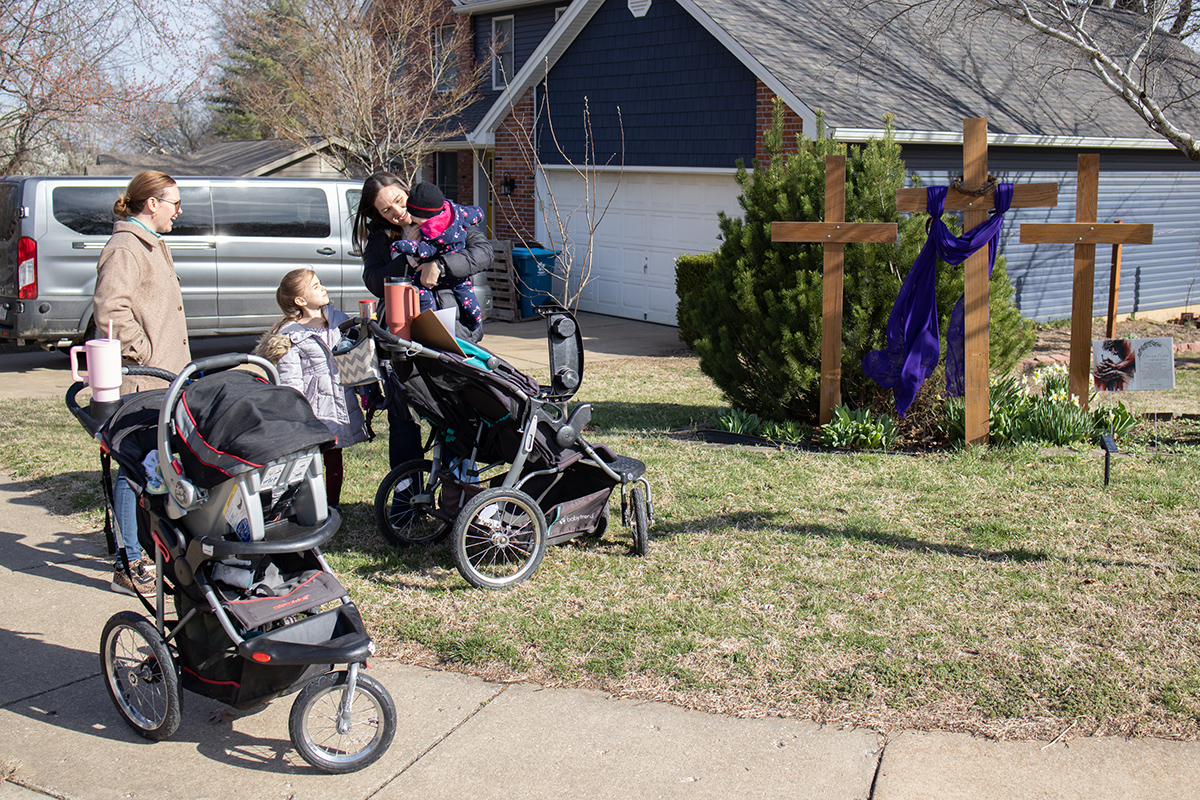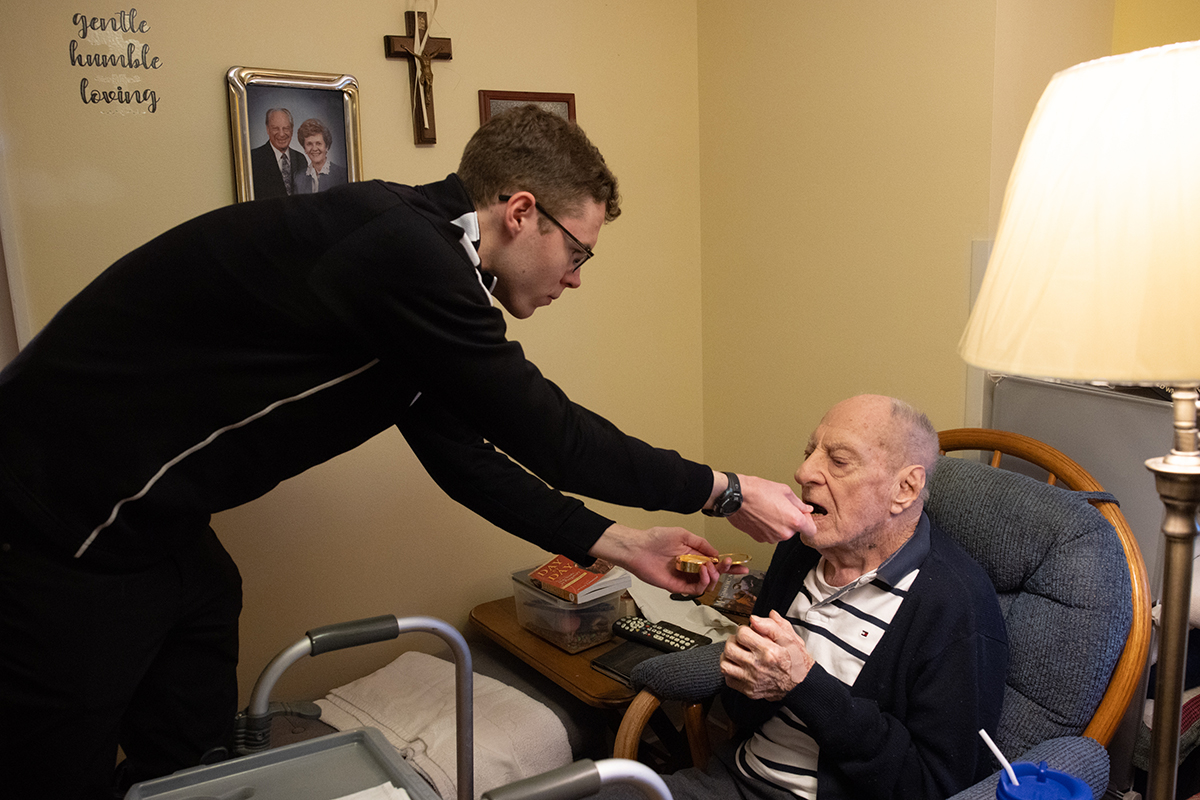Crossing a Frontier

As the Archdiocese of St. Louis celebrates Catholic Schools Week, the Academy of the Sacred Heart traces its roots to the founding of Catholic education here 200 years ago
When St. Rose Philippine Duchesne ventured from France to the New World to establish schools here, the 70-day voyage across the Atlantic was certainly rife with hardships.
She had little money. Didn’t know the culture. And she ate rock-hard sea biscuits on the voyage.
These were lessons learned by students at the Academy of the Sacred Heart in St. Charles, as part of Catholic Schools Week, which kicked off Jan. 28.
“Two hundred years ago on this very day, Philippine was busy procuring passports to America, seeking financial assistance from all her cousins to help pay for her travels, writing farewell letters to her sisters and gathering with her family to say goodbye,” principal Marcia Renken said at a morning prayer service during Catholic Schools Week.
Students dressed in authentic habits representing St. Philippine Duchesne and her superior, St. Madeline Sophie Barat, stood on an oversized world map to demonstrate the voyage that St. Philippine Duchesne made to America. Candles were placed on the map to show the impression the Society of the Sacred Heart has made around the world over the centuries — with 24 schools in the United States and Canada and more than 150 schools in 30 countries worldwide.
Drawn to a life of religious service, St. Philippine Duchesne led a mission of five nuns to St. Louis in 1818, settling in the frontier town of St. Charles, where she established the Academy of the Sacred Heart, the first free school west of the Mississippi. She later also opened convents, schools and orphanages in Florissant and St. Louis. At the age of 72, she moved to Kansas to help establish a school for the Potawatomi tribe, who called her the “Woman Who Prays Always.” She was canonized in 1988.
Her journey here was not easygoing, though. Even thought she came to St. Louis at the invitation of Bishop William DuBourg, she was given notice that her community would be on its own to support themselves.
“The religious who are going with me have nothing to contribute except their good will,” St. Philippine Duchesne wrote in a Jan. 24, 1818, letter to her cousin Josephine, as detailed in “Philippine Duchesne: Frontier Missionary of the Sacred Heart,” a 1957 book by Louise Callan. She continued: “The bishop warned us not to count on him for financial aid. The expense of the voyage and the necessity of providing a dwelling place will use up all the money.”

The stories have been told time and again, and they need to be retold to future generations, said Sister Margaret Munch, a Religious of the Sacred Heart for nearly 60 years who still serves at the Academy of the Sacred Heart after more than two decades of teaching there.
St. Philippine Duchesne’s sacrifices are “an inspiration for us to go and do likewise, to serve others, to have a life of prayer with God, and to share that love with everybody that we can possibly influence,” she said.
The details of St. Philippine Duchesne’s journey are shared in a series of lesson plans developed earlier this year by a group from Sacred Heart Academy and Duchesne High School. The lessons have been made available to the public online and to all Catholic schools in the archdiocese in celebration of the bicentennial anniversary of the saint’s arrival here. (See related item.)
The lessons provide hands-on experiences, such as making sea biscuits, a dehydrated treat made of flour and water — and maybe a pinch of salt for a little bit of flavor. St. Philippine Duchesne and her fellow sisters would have consumed these on the journey, as their long shelf life and portability made them ideal for long trips and in times of war.
But today, when opportunities for sustenance are practically on demand, the idea of St. Rose Philippine consuming a sea biscuit can be foreign. Fifth-graders in Tammy Strother’s class spent a recent morning making their own biscuits. They quickly discovered that mixing and kneading the dough was tough work, and the payoff wasn’t much — rock-like discs that didn’t taste all that great. Strother gave her students apple juice to dip the biscuits and soften them, only then making them slightly palatable.
Student Kade McPherson succinctly summed it up for his fellow students when he took one whiff of the dough and exclaimed, “it smells like wood chips.”
But the lessons have been a teachable moment that delve into St. Philippine Duchesne’s missionary heart and the sacrifices she made to come to the New World to educate children.
As an alum and with 35 years of work at the academy, principal Marcia Renken knows the saint’s story. But “the lesson plans have peeled back yet another several layers to get down more into it and get a real sense of how long it took, how bad it was.
“We know those highlights, and we know some of those quotes that have spoken to us over the years,” Renken said. “Our focused energy throughout the year is causing us to pause and to ponder the power of one single woman in that time period. It’s a story of dedication, hard work, prayer, perseverance and waiting … She waited a long time to get what she wanted. I think there’s a great benefit to how we are using the lesson plans to teach us about someone who walks before us, but to allow us to believe we can be determined enough to make something great happen.”
Bicentennial events
Frontiers Conference: July 19-22 at Pallottine Renewal Center in Florissant. The academic conference will feature numerous speakers and explore how the Society of the Sacred Heart is going to the frontiers in modern times.
Missouri History Museum presentation: Thursday, July 19, at the Missouri History Museum. Journalist and author Cokie Roberts, a Sacred Heart schools aulmna, will speak on Pioneering Women.
Re-enactment of St. Rose Philippine Duchesne’s arrival: Friday, Sept. 7, at Frontier Park in St. Charles. Duchesne High School students will perform a short play re-enacting the story of St. Rose Philippine’s role in founding the first institution of formal education in St. Charles. Festivities begin at 9 a.m., with the re-enactment beginning at 10:30.
Global Service Day: An international day of service in honor of St. Rose Philippine will take place Saturday, Sept. 15.
Closing Mass: A Mass will be celebrated at 2:30 p.m. Sunday, Nov. 18, (St. Rose Philippine’s feast day) at the Cathedral Basilica of St. Louis.
Pilgrimages: The Society of Servant Pilgrims will host two walking pilgrimages from Mound City, Kan., to St. Charles, April 29-May 23 and Oct. 23-Nov. 17. For more information or to sign up, visit rscj.org/bicentennial2018/mound-city-st-charles.
For more information on bicentennial celebration events, visit www.rscj.org/bicentennial2018.
Bicentennial lesson plans
A group from the Academy of the Sacred Heart and Duchesne High School have developed seven lesson plans for students in kindergarten through 12th grade, which outline the details of St. Rose Philippine Duchesne’s journey to the New World to establish schools here. The lesson plans have been made available to all Catholic schools in the archdiocese. A new lesson is posted each month online at www.duchesne-hs.org/lesson-plans.html.
>> Sea Biscuits
This is a basic recipe for English sea biscuits (also known as hardtack) commonly brought on long sea voyages for centuries. Dried biscuits could last for months, even over a year, if stored properly. It is an example of the kind of provisions St. Rose Philippine Duchesne likely would have had during her 70-day voyage to the New World in 1818.
2 cups of whole wheat flour
1 cup white whole wheat pastry flour (or all-purpose flour)
1 cup plus 2 tablespoons of water
Pinch of salt (optional)
Preheat oven to 375 degrees. Combine flour and pinch of salt, adding water and mix by hand. Add an additional tablespoon of water it the dough is too stiff to mix by hand. (The dough will be denser than bread dough.)
Knead dough for several minutes until smooth, and divide into three to five pieces. Hand roll each piece until round like a dinner roll. Press down the dough until it is about 1/2 inch thick. If the dough cracks or the edges or splits, then more kneading is required.
Make evaporation holes in the dough using a pizza docker or ice pick. The holes should be about 3/4 inch apart from each other and cover the entire surface of the biscuit. Place biscuits on a cookie tray and bake for one hour. The oven door may be opened once or twice to let the evaporating water escape.
Remove the biscuits and place them on a cookie rack to cool. Continue to dehydrate them by leaving them exposed. The biscuits will be ready after they have dried for several days. They will keep indefinitely if stored in a dry, cool place.
When St. Rose Philippine Duchesne ventured from France to the New World to establish schools here, the 70-day voyage across the Atlantic was certainly rife with hardships. She had little … Crossing a Frontier
Subscribe to Read All St. Louis Review Stories
All readers receive 5 stories to read free per month. After that, readers will need to be logged in.
If you are currently receive the St. Louis Review at your home or office, please send your name and address (and subscriber id if you know it) to subscriptions@stlouisreview.com to get your login information.
If you are not currently a subscriber to the St. Louis Review, please contact subscriptions@stlouisreview.com for information on how to subscribe.







